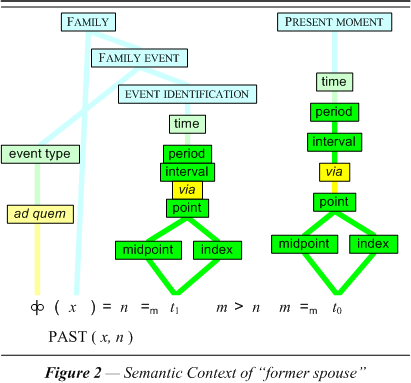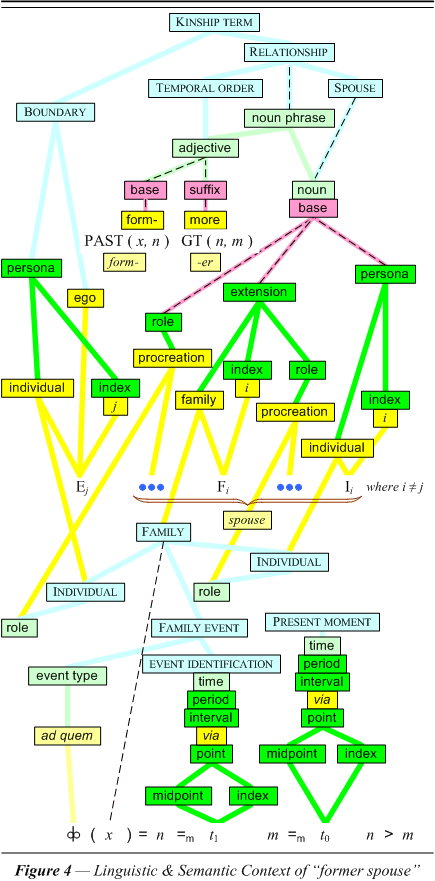
Having introduced the context of the family with its vital events, which are connected to time, we are prepared to look deeper at the meaning of some of the British kinship terms.
Semantic context of “older sibling”. The environment of the nuclear family provides a structure where we will be able to compare the ages of two of the individual members. The ages relate the time of their birth event to the time of the present moment to see which is larger. To do this the time interval must be expressed in standard terms (metrified). Figure 1 expresses some of these ideas formally. Notice that there is a predicate assumed for the birth event whose argument represents the individual. In order to be comparable the two points in time (t1 and t2) are in terms of a common measure as n and m. The first order predicate calculus (FOPC) allows an individual’s age to be expressed as OLD(x,n). This calculus can also express the concept of greater-than (>) as a two-place predicate (operation) with two numbers as arguments: GT(m,n).

Semantic context of “former spouse”. The environment of the nuclear family also provides a structure where we will be able to compare the disolution of an individual’s family of procreation to the present moment. The time interval between that disolution and the present need not be expressed in standard terms (metrified), but should be determined to be positive. Figure 2 expresses some of these ideas formally. Notice that there is a predicate assumed for the disolution event whose argument represents the family of procreation. For uniformity with the other kinship terms, we have metrified the two points in time (t0 and t1) as n and m. The first order predicate calculus (FOPC) allows a state that has ceased to exist to be expressed as PAST(x,n). This calculus can also express the concept of greater-than (>) as a two-place predicate (operation) with two numbers as arguments: GT(m,n).

Adding linguistic context to “older sibling”. In figure 3 the linguistic context has been added to figure 1. The adjective base for older has been given a primitive semantic element to which to attach the FOPC predicate and the suffix -er an element for the FOPC comparison operator. The contextual elements for individuals are attached to the corresponding semantic elements of the kinship chain interpretation. Notice too that we have attached the “role” elements in the family context to the “orientation” roles of the kinship chain.

Adding linguistic context to “former spouse”. In figure 4 the linguistic context has been added to figure 2. The adjective base for former has been given a primitive semantic element to which to attach the FOPC predicate and the suffix -er an element for the FOPC comparison operator. The contextual elements for the family and an individual are attached to the corresponding semantic elements of the kinship chain interpretation. There are also “role” elements in the family context that are attached to the “procreation” roles of the kinship chain.

